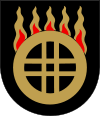Sonkajärvi
| Sonkajärvi | ||
|---|---|---|
| Municipality | ||
| Sonkajärven kunta | ||
| ||
 | ||
| Coordinates: 63°40′N 027°31′E / 63.667°N 27.517°ECoordinates: 63°40′N 027°31′E / 63.667°N 27.517°E | ||
| Country | Finland | |
| Region | Northern Savonia | |
| Sub-region | Upper Savonia | |
| Charter | 1922 | |
| Government | ||
| • Municipal manager | Simo Mäkinen | |
| Area(2011-01-01)[1] | ||
| • Total | 1,576.77 km2 (608.79 sq mi) | |
| • Land | 1,465.91 km2 (565.99 sq mi) | |
| • Water | 110.86 km2 (42.80 sq mi) | |
| Area rank | 64th largest in Finland | |
| Population (2014-01-31)[2] | ||
| • Total | 4,596 | |
| • Rank | 203rd largest in Finland | |
| • Density | 3.14/km2 (8.1/sq mi) | |
| Population by native language[3] | ||
| • Finnish | 99.6% (official) | |
| • Swedish | 0.1% | |
| • Others | 0.4% | |
| Population by age[4] | ||
| • 0 to 14 | 14.1% | |
| • 15 to 64 | 62.7% | |
| • 65 or older | 23.1% | |
| Time zone | EET (UTC+2) | |
| • Summer (DST) | EEST (UTC+3) | |
| Municipal tax rate[5] | 19.75% | |
| Website | www.sonkajarvi.fi | |
Sonkajärvi is a municipality of Finland.
It is located in the province of Eastern Finland and is part of the Northern Savonia region. The municipality has a population of 4,596 (31 January 2014)[2] and covers an area of 1,576.77 square kilometres (608.79 sq mi) of which 110.86 km2 (42.80 sq mi) is water.[1] The population density is 3.14 inhabitants per square kilometre (8.1 /sq mi).
The municipality is unilingually Finnish.
Sonkajärvi has gained a worldwide fame for Wife Carrying (Finnish: akankanto or eukonkanto) which is an alternative sport of carrying women. The first Wife Carrying World Championship dates to 1994, but the creation of the contest, apart from its humorous aspects, has deep roots in the local history. In the late 19th century there was in the area a brigand called Rosvo-Ronkainen, who is said to have accepted in his troops only those men who proved their worth on a challenging track. In those days, it was also a common practice to steal women from the neighbouring villages.
In the Wife Carrying competition each team has one male and one female member, the objective being for the male to carry the female through a special obstacle track. The basic rules are that the woman must be over 17 years of age and have a weight of at least 49 kilograms (108 lb). If she is below that weight, she must be burdened with such a heavy rucksack so that the total weight to be carried by the man is at least 49 kilograms. The only equipment allowed is a belt worn by the carrier. The track in Sonkanjärvi used annually for the World Championship has a length of exactely 253.5 metres (832 ft).
The winning couple in the 2008 edition of the World Championship was Inga Klauson and Madis Uusorg, from Estonia.
International relations
Twin towns — Sister cities
 Väike-Maarja Parish, Estonia (since 1997)[6]
Väike-Maarja Parish, Estonia (since 1997)[6]
References
- ↑ 1.0 1.1 "Area by municipality as of 1 January 2011" (PDF) (in Finnish and Swedish). Land Survey of Finland. Retrieved 9 March 2011.
- ↑ 2.0 2.1 "VÄESTÖTIETOJÄRJESTELMÄ REKISTERITILANNE 31.1.2014" (in Finnish and Swedish). Population Register Center of Finland. Retrieved 11 February 2014.
- ↑ "Population according to language and the number of foreigners and land area km2 by area as of 31 December 2008". Statistics Finland's PX-Web databases. Statistics Finland. Retrieved 29 March 2009.
- ↑ "Population according to age and gender by area as of 31 December 2008". Statistics Finland's PX-Web databases. Statistics Finland. Retrieved 28 April 2009.
- ↑ "List of municipal and parish tax rates in 2011". Tax Administration of Finland. 29 November 2010. Retrieved 13 March 2011.
- ↑ "Sõprusvallad" (in Estonian). Väike-Maarja vald. Retrieved 21 March 2011.
External links
![]() Media related to Sonkajärvi at Wikimedia Commons
Media related to Sonkajärvi at Wikimedia Commons
- Municipality of Sonkajärvi – Official site (Finnish)
| ||||||||||||||

